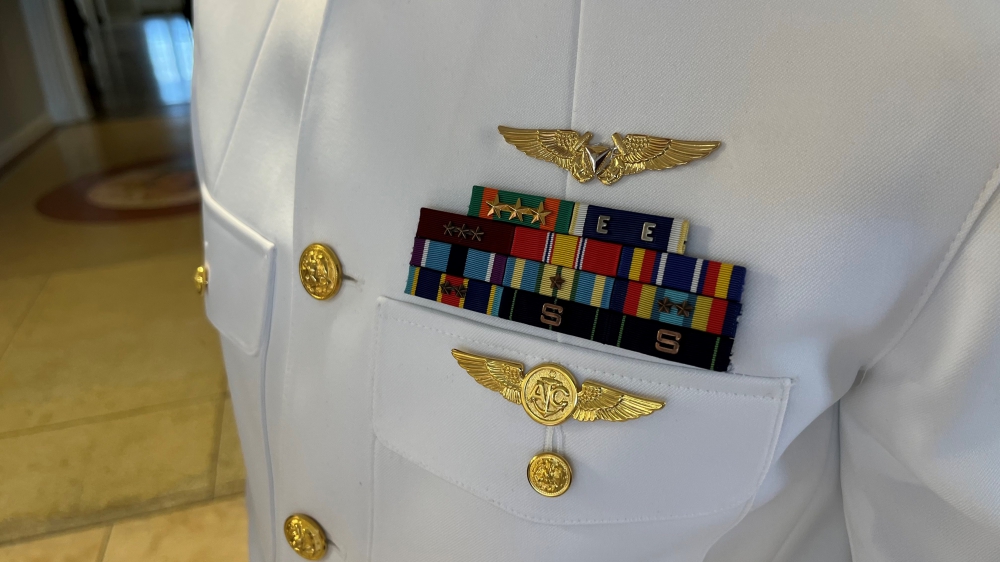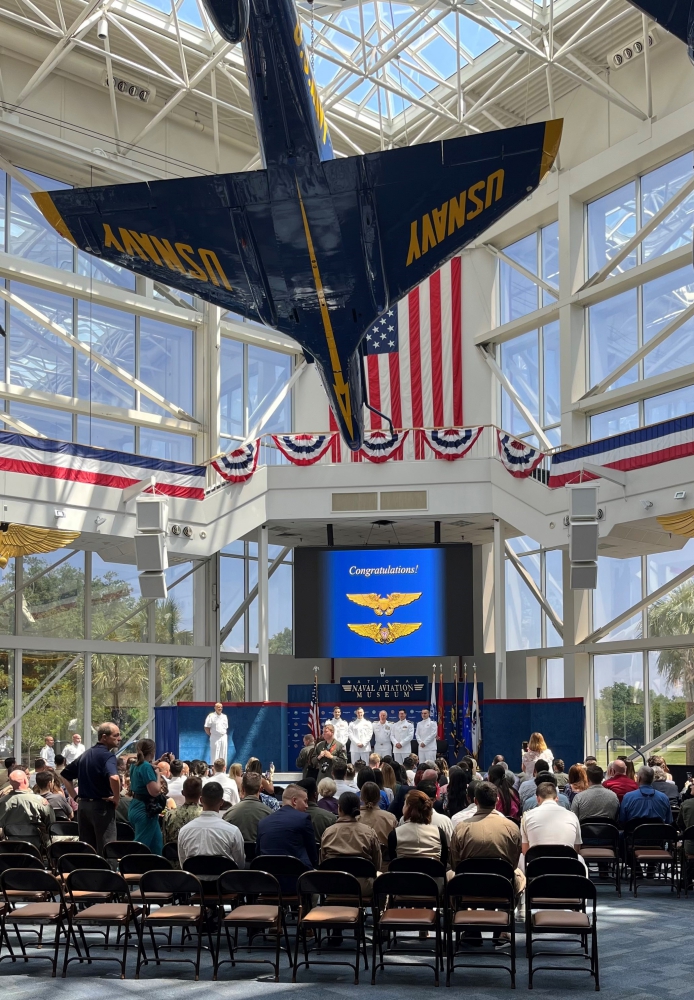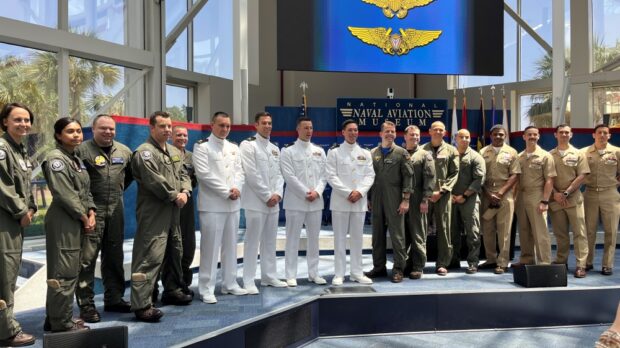The first four air vehicle pilots (AVP) completed flight training and earned their “Wings of Gold,” during a ceremony aboard Naval Air Station (NAS) Pensacola, May 25.
The four AVPs were winged at the National Naval Aviation Museum alongside a graduating class of Naval Flight Officers (NFO). The AVPs are the first service members authorized to wear the AVP warfare device. The device is similar to traditional Naval Aviator wings but with an inverted delta displayed on a shield centered on two crossed anchors and flanked by wings. Service members qualified to wear this device will belong to a new community of aviation professionals who operate the MQ-25 Stingray and future unmanned aerial systems.

The newly designed air vehicle pilot warfare pin or “Wings of Gold” are proudly worn on the uniform of one of the first four air vehicle pilots to complete CNATRA led training
During the ceremony, Vice Adm. Kenneth Whitesell, Commander, Naval Air Forces, was the senior officer in attendance. He delivered remarks to the newly winged service members as the guest speaker.
“Todays winging ceremony for both the manned and unmanned aviators is symbolic of the manned-unmanned team that will shape our force for years to come as defined by the strategy of the Chief of Naval Operations,” said Whitesell. “By combining the versatility and flexibility of the manned and unmanned platforms with the power and strength of traditional aircraft we simultaneously increase the capacity of survivability of our deployed air wings and our surface forces.”
Following Whitesell’s remarks, spouses, parents and other family members pinned the wings on the new AVPs.
Warrant Officer Kiel Massong, a former MH-60R Seahawk aircrewman, is one of the first four students to earn the AVP wings.
“I’m extremely thankful to have been selected for the program and for the opportunity to be part of the changing landscape of Naval Aviation,” said Massong. “The ability to fly [unmanned aerial vehicles] gives us a huge competitive advantage enabling us to operate in dangerous areas with less risk to our team. Having automated systems that mitigate our vulnerability and enhance our capability at sea is a huge factor.”
These first four AVPs are leading the way for their new community as they prepare to operate the MQ-25 Stingray and future unmanned platforms. A second class of AVPs will earn their “Wings of Gold” in September.
The MQ-25 Stingray is set to be the first carrier-based unmanned aircraft and will provide aerial refueling and airborne intelligence capabilities to enhance the capabilities and versatility of the carrier air wing (CVW). This platform is the latest addition to the “Air Wing of the Future,” which includes other advanced platforms such as the F-35C Lightning II and the CMV-22B Osprey. Eventually, all Nimitz and Ford Class carriers will be capable of deploying with the MQ-25.
Chief of Naval Air Training (CNATRA) Rear Adm. Richard Brophy oversees the development of AVP undergraduate training including primary, intermediate and advanced AVP training syllabi.
“Air Vehicle Pilots will play a pivotal role in enhancing the capabilities of our carrier air wings in the next few years as they prepare to operate the MQ-25 Stingray,” said Brophy. “Their addition to our fleet will be a milestone achievement that pioneers the mission integration of manned and unmanned aircraft at sea. This integration will ultimately provide the most ready and lethal carrier air wing.”

The first four Air Vehicle Pilots (AVP) to graduate a new CNATRA led training syllabus and earn their AVP wings of gold stand alongside Vice Admiral Kenneth Whitesell, Commander, Naval Air Forces at a winging ceremony in the National Naval Aviation Museum
CNATRA blends the initial stages of traditional Naval Aviator training with unique training necessary to operate the MQ-25 Stingray. AVPs undergo the Naval Introductory Flight Evaluation (NIFE) training that is required of all Naval Aviators embarking on their first stage of training. AVPs then utilize T-6B Texan II simulators as part of the Primary Naval Air Vehicle Pilot Training System (NAVPTS). Primary NAVPTS provides basic aviation fundamentals and an appreciation for the operation of traditionally manned platforms.
As students progress through intermediate and advanced NAVPTS, they focus increasingly on Stingray-specific operations and mission skills learning on the same Multi-Crew Simulators (MCS) utilized by student NFOs destined for other platforms such as the P-8 Poseidon. The simulator combines fleet derived sensors with realistic adversarial problem sets requiring the operator to utilize and demonstrate naval tactics, techniques and procedure-based skills.
Now finished with undergraduate training, the new AVPs will report to NAS Patuxent River, Maryland, to train with Unmanned Carrier-Launched Multi-Role Squadron (VUQ) 10. VUQ-10, like other fleet replacement squadrons (FRS), will take winged aviators and prepare them to fly their specific platform in the fleet, in this case, the MQ-25.
CNATRA trains, mentors, and delivers the highest quality Naval Aviators who prevail in competition, crisis, and conflict. Headquartered at NAS Corpus Christi, CNATRA comprises five training air wings in Florida, Mississippi, and Texas, which are home to 17 training squadrons. In addition, CNATRA oversees the Navy Flight Demonstration Squadron, the Blue Angels and the training curriculum for all fleet replacement squadrons.
Top Photo: The first four air vehicle pilots (center in white) to graduate a new CNATRA led training syllabus and earn their AVP wings of gold pose for photos alongside fellow service members at a winging ceremony in the National Naval Aviation Museum
All Photos: US Navy Photo by Ensign Elias Kaser
Source: Press Release

